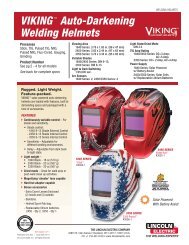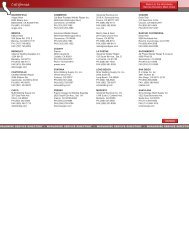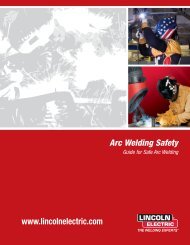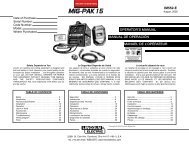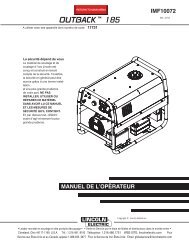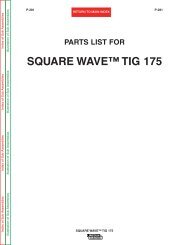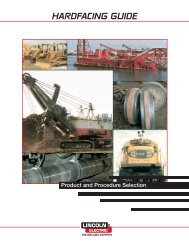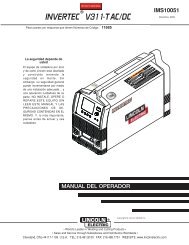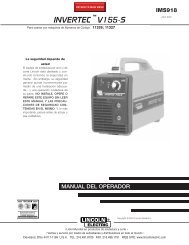Innershield Welding Guide (pdf) - Lincoln Electric
Innershield Welding Guide (pdf) - Lincoln Electric
Innershield Welding Guide (pdf) - Lincoln Electric
Create successful ePaper yourself
Turn your PDF publications into a flip-book with our unique Google optimized e-Paper software.
FUMES AND GASES<br />
can be dangerous.<br />
5.a. <strong>Welding</strong> may produce fumes and gases<br />
hazardous to health. Avoid breathing these<br />
fumes and gases.When welding, keep<br />
your head out of the fume. Use enough<br />
ventilation and/or exhaust at the arc to keep<br />
fumes and gases away from the breathing zone. When<br />
welding with electrodes which require special<br />
ventilation such as stainless or hard facing (see<br />
instructions on container or MSDS) or on lead or<br />
cadmium plated steel and other metals or coatings<br />
which produce highly toxic fumes, keep exposure as<br />
low as possible and below Threshold Limit Values (TLV)<br />
using local exhaust or mechanical ventilation. In<br />
confined spaces or in some circumstances, outdoors, a<br />
respirator may be required. Additional precautions are<br />
also required when welding on galvanized steel.<br />
5.b. Do not weld in locations near chlorinated hydrocarbon<br />
vapors coming from degreasing, cleaning or spraying<br />
operations. The heat and rays of the arc can react with<br />
solvent vapors to form phosgene, a highly toxic gas, and<br />
other irritating products.<br />
5.c. Shielding gases used for arc welding can displace air and<br />
cause injury or death. Always use enough ventilation,<br />
especially in confined areas, to insure breathing air is safe.<br />
5.d. Read and understand the manufacturer’s instructions for<br />
this equipment and the consumables to be used, including<br />
the material safety data sheet (MSDS) and follow your<br />
employer’s safety practices. MSDS forms are available from<br />
your welding distributor or from the manufacturer.<br />
5.e. Also see item 1.b.<br />
WELDING SPARKS can<br />
cause fire or explosion.<br />
6.a. Remove fire hazards from the welding area.<br />
If this is not possible, cover them to prevent<br />
the welding sparks from starting a fire.<br />
Remember that welding sparks and hot<br />
materials from welding can easily go through small cracks<br />
and openings to adjacent areas. Avoid welding near<br />
hydraulic lines. Have a fire extinguisher readily available.<br />
6.b. Where compressed gases are to be used at the job site,<br />
special precautions should be used to prevent hazardous<br />
situations. Refer to “Safety in <strong>Welding</strong> and Cutting” (ANSI<br />
Standard Z49.1) and the operating information for the<br />
equipment being used.<br />
– 7 –



